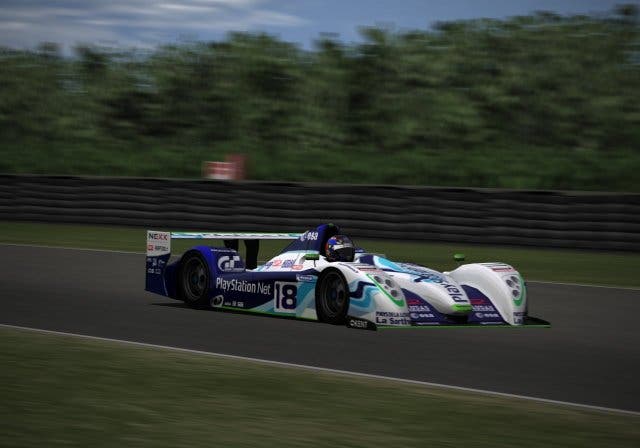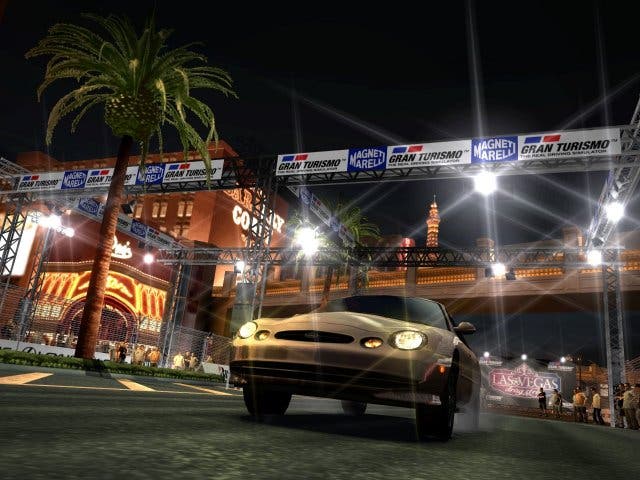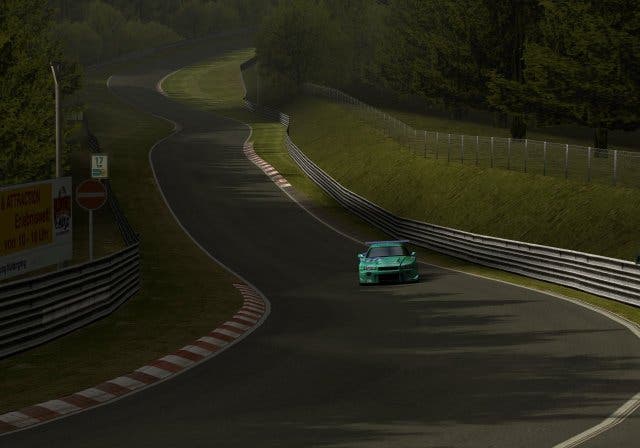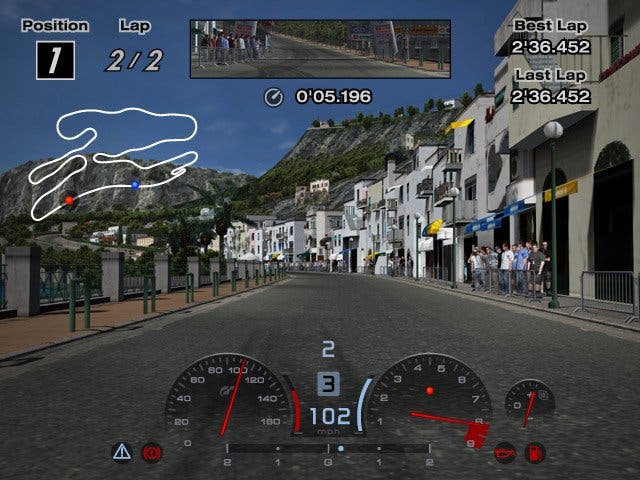Gran Turismo 4
The ultimate driving simulator, maybe. But the ultimate racing game?

At its heart, what Polyphony Digital wants Gran Turismo 4 to do is make you feel like you're driving a lot of increasingly expensive cars. Surprisingly. But we mean it wants to make you feel like you're really driving them. This it does with aplomb. As you move further away from its heart (into the ventricles, perhaps), you find that it also wants you to learn how to drive these increasingly expensive cars properly. And it wants you to understand what's better or worse about each of them compared to the other 700. It knows only too well what the difference is, see, and over four iterations on both PlayStations it's developed an enormous number of ways to underscore these differences and get you to understand them.
GT4, like the other GT games, first wants you to complete a serious of increasingly meticulous "Licence Tests", which are your gateway to being able to enter increasingly difficult (and increasingly profitable) races, and test every aspect of your driving from your judgement of braking distances to your ability to corner at different speeds in different cars. It's as much a learning experience as anything, and the bronze/silver/gold medals make for a pleasurable, arcade-esque challenge. It's comparable on this level to Gotham's Kudos challenges, except it wants driving precision rather than driving flair.
It's here that you get your first sense of how much the handling has changed for the better - or, if you're new, simply that it's a lot more animated and engaging than you've been told. The cars used in Licence Tests, plucked from far and wide to try and teach you about particular elements of automotive behaviour, are surprisingly fun to drive from the lowliest town car up to the most uncompromising juggernaut.
When you eventually emerge with a B Licence, the typically ugly and inefficient opening salvo of vehicles for your Garage (beginning with a VW Lupo - cheers chaps) can be largely ignored in favour of spending your first few credits on something nippy and second-hand (particularly if you're a veteran of GT3 or GT4 Prologue, save game files for which give you in-game cash and Licence bonuses). This allows you to pick out something outwardly unexciting like an MX-5 from an early 90s dealer, only to discover much to your delight that it lurches round bends feeling, sounding and rattling your hands provocatively. There's more feedback and sense of things like suspension and engine position, and it's more challenging with it. The price of enjoying yourself more early on is having to work harder later.

Visually of course everyone knows that it's unparalleled on the PS2 and makes everything else - including GT3 - look grainy, jagged and underdeveloped by comparison. (And we have done direct comparisons; loading up Tsukuba Circuit in games like Enthusia is like going back in time after GT4.) The only complaint we can have is that you need to live in the USA to take advantage of the 480p or 1080i progressive scan modes. It's so well known that it's good looking, in fact, that we're not going to go to great lengths to re-expose that fact. Partly because you can see very well for yourself, but mainly because it's more than the visuals that make it stand out. It's the way every little imperfection in the track surface is reflected by little jolts to your bumper cam view, tiny throbs of the pad in your hands and the little inflections in the sound of the wind rushing past you at high speed.
It's the little touches, like your car's reaction to a rumble strip just telling you that you won't have sufficient downforce and traction to take the corner. The trackside detail and little cameramen snapping away at your bonnet on rally stages and then jumping out of the way as you peel off the start line. The way that front-engine and rear-engine cars require a different cornering mentality and that you can tell that in seconds. The sense of awesome speed that you suddenly get when you find something that's 200bhp beyond what you were previously driving. The way that you can eventually walk out of the room, have your mate fiddle with the car set-up and, with practice, actually realise what's changed when you get back. The tyres, right? Wax on, wax off. Surround sound is a must. So's a steering wheel. GT's got all the parts to make you into a first-class driver, and it's your own fault if you don't bring the tools.
After the Licence Tests, you're thrust into "Gran Turismo World", a big world map populated by country icons, (each of which harbours an array of car manufacturers from that area), second-hand car dealers, tuning shops, test rings, circuits you've unlocked (split into obvious categories like World Circuits, Originals, Dirt & Snow, etc), continental events, Endurance Races and of course Beginner, Professional and Extreme events. From here you can also fiddle with the Jukebox (populated by an extraordinarily vast and fairly eclectic mix of songs - with everything from J-Rock to Soulwax) and find other driving tasks to complete.
The structure is unashamedly GT, and the size of the task sprawled out in front of you as you enter GT World is sizable. A whole week and tens of hours weren't enough to get the "game completion" figure looking anywhere near respectable. It's extremely daunting, and although the handholding in the Licence Tests - complete with increasingly detailed explanations of the driving theory that applies to each challenge, as ever - is welcome, the lack of any subsequent help means that progress will be as slow or as fast as your random exploration of the GT World map lets it be.

If you don't discover that you can win 265,000 credits' worth of car by completing some relatively easy Special Conditions races, for example, it might be a whole Final Fantasy game's worth of play before you've managed to actually walk into one of the game's myriad car dealers and buy something that doesn't have "One woman owner, 35,000 miles, new CD player" written on the spec sheet. Let alone be able to race competitively. But what's really extraordinary, you might well argue, is that it doesn't even suggest a car you might consider buying. What if it doesn't occur to you to try and find a cheap MX-5? Fortunately, what's also really extraordinary - and perhaps the most satisfying change to the game from a critical standpoint - is that the revised handling means you'll have fun even if you don't figure that out for a week.
Once you've made those first stumbling revs without the child locks on, you'll discover that it's still mostly race-based, covering every manner of circuit (track, street, countryside, rally, snow, etc), but that the Special Conditions and Driving Missions sections add some hitherto unseen character. The former features tasks that might involve winning normal and reserve layouts of particular tracks in tougher one-on-one duels, with the reward being expensive high-end models or concept cars from big manufacturers. The latter section tasks, meanwhile, are not unlike Licence Tests in that they're specific tasks on specific sections of tracks, but here they involve other vehicles, so you may find yourself having to overtake over a certain short and windy stretch of the Autumn Ring track, for example. Which, given the technique you have to apply, makes Gotham's overtaking challenges seem like a slide puzzle next to a Rubik's Cube by comparison.
Speaking of the Autumn Ring, the tracks seem like a good place to go next - and not only are there too many to individually name-check them, but there are too many to even reasonably count all the variations, which even include period versions like multiple historic adjustments to the Fuji Speedway. On the whole the choices from around the world are wonderful - and brought wonderfully to life in-game. Some may be disappointed that Polyphony doesn't opt to design more of its own tracks, but the general level of quality and quantity of quality is admirable. Personal favourites include a winding mountainside street race on roads barely three car widths wide, the broad turns followed by sharp cutbacks of the hilly El Capitan, and of course the much vaunted addition of the enormous Nurburgring Nordschleife, which is so big you can barely pick out the turns on the mini-map, and one of the most visceral driving experiences we've ever enjoyed. We're told by people who'd know that the adjustments made to returning tracks make for more realistic cornering conundrums than ever, and it feels like it.
With so many tracks and so many cars (did we mention that every car manufacturer has races specific to their cars available to compete in, too?) the sheer depth can be terrifying (particularly for a reviewer on a deadline, eh Mr. 5:37am?) but it never leaves you with nothing to do, and the character of the various tasks differs sufficiently that you won't be tempted to pull over when it frustrates you. Racing against a tough grid of cars which clearly can be overhauled with practice can occupy you for hours at a time, but if you tire of that you always can try a completely different driving discipline (and although you may think we mean dirt or snow, it's a description that just as easily fits a lot of the other car set-ups that might be ostensibly similar on the surface). Or you can go back to complete another round of Licence Tests - a discipline in itself, which instils a chip-away mentality that has you going back to try and edge them all up to silver. Tum te tum BAH, restart, tum te tum, ooh, tum, BAH, restart. Etc. The sort of dominating pursuit-of-perfection sensation that we were associating with TrackMania not too long ago.

You can also spend time with the game's other additions - the B-Spec and Photo modes. B-Spec basically involves managing an AI driver racing in your place. You can tell him to be aggressive, overtake, pit, etc, and view his work from different angles. Although it's arguably little more than a novelty in most cases, it's nice to be able to swap from A to B-Spec in the pits during Endurance Races, and, as we realised recently, it's also a nice excuse to keep playing while you're eating your dinner. Photo mode, meanwhile, allows you to set up complex photo opportunities for your favourite cars, frame them nicely and then save them or send them to a USB printer. We've explored Photo mode in more depth here.
But, as we've said, it's a game that demands the right set-up to enjoy thoroughly. Surround sound and widescreen support make a huge difference. PS2 owners with portable TV perched on the shelf and one slightly knackered pad will not enjoy it to the same degree as people like ourselves. The problem, to return to the heart of the game with a stake in-hand, is that the further you move away from the core focus of the game - the driving - the more you realise that some pretty significant elements have been left rotting in stomach acid. Again. The Dual Shock 2, for example, simply cannot cope with the kind of feather-light touch GT demands. Controlling your speed round corners may be possible with practice in specific Licence Tests, likewise careful steering - but on the track it's twitchy, and the pace and pressure means you find yourself braking too little, accelerating too much and often worse.
You can cope with a pad, and the little on-screen indicators that give you an idea which gear you should be in ahead of a corner help dull the ill effects of the precision the pad struggles to let you command effectively, but you'll never quite master the sort of fractional adjustments and minor compensation that you'll need to be able to apply in a split-second to succeed. The twitchy steering is one thing, but we're also talking about the analogue face buttons. It was hard enough to control your speed using analogue triggers in Gotham on an Xbox pad, but the PS2's X button acts like it's been conscripted and thrust into the general's tent on the same day; it drinks the wine and takes on advice, but it's orders are often misjudged because it's just not the right man for the job. Don't get us wrong; GT4 is fine on a pad. It's just not Super Fine, despite the Photo mode.
Meanwhile, the AI is still taking the piss rather than pumping the lifeblood as it should be. No wonder some of our friends have been spewing bile at it already. After four games, it's shocking to discover that the AI cars still follow a clear line around each track, heartlessly cut back in front of you even when it's obvious you'll hit them as a result, ram your back end and allow you to crawl around the inside of them on corners you have no right to overtake on by using them as buffers. As one US reviewer perceptively noted, if you sit still on the finish line and let them complete a lap and come back round, they will literally slam right into you as if you're not there.

The game stops letting you get away with bashing AI drivers in certain areas by penalising you with a five-second speed restriction for smashing into other drivers or walls, but even this is ineffectual on tightly designed courses where you barely accelerate away from hairpins anyway - making them an ideal point to start bending the rules in your favour - and even more maddeningly Polyphony seems to have bottled it over this system of penalties by not applying them to the rest of the game. GT is all about driving, so widespread enforcement would seem to be the obvious thing to do, because if you can tip the balance in your favour through a bit of argy-bargy, chances are you're going to do it before too long. A bizarre choice.
Another aspect of that problem is the lack of vehicle damage. Not the aesthetic side of it (we're increasingly led to suspect that the lack of tangible external damage to cars doesn't make a huge amount of difference to people who want to play GT the way it was intended, and that really it's just something handy for journos to ask when series creator Kazunori Yamauchi pops up for a ten-minute Q&A at a trade show), but rather the lack of punishment for impacting on other cars. We seem to remember knackering our suspension by overdoing it in previous GT games, but not so here. Hitting the sand or gravel can have a catastrophic effect on your lap times, but bashing other vehicles generally upsets them by knocking them off their racing lines more than it upsets you.
There's also little restriction on which cars you can actually use in which races, so for a large section of the game if you're income is reasonable you can take hugely outspecced cars onto humble grids and dominate. And we have to confess to doing a certain amount of that. It's just begging to be done, particularly when you're on a deadline; whether that's a copy deadline or a put-the-kids-to-bed-and-watch-a-romcom-with-the-missus deadline. The game's A-Spec points system tries to convince you not to by giving you larger points totals for using relatively underpowered cars, with a points bonus proportionate to your horsepower deficit on the grid, but A-Spec points seem to be more about bragging rights than tangible gains. So who cares, most will ask. And those who do may just bash their way to the front from a standing start and then just block their way to victory. D'oh. There are so many things the game does occasionally to force you to play it properly - penalties, rolling starts to stop you terrorising the first corner, etc - but it gives you the benefit of the doubt way too much. Polyphony: we are gamers; we were brought up to try and succeed, and we exploit things where we can, so stop letting us do it so much.
And, while you're at it, sort out this online/not offline nonsense. You told us it was in, then you were downbeat about it, then you were upbeat, then it was gone. No wonder the (admittedly impressive) split-screen modes and (never to be used by 90 per cent) six-player LAN options aren't doing much for your fans. We're not marking this down because it's not there, but if it were here then it might ease the pain of having to race against pre-programmed automatons.

As you might be starting to realise by now, Gran Turismo's problems are no longer mechanical or particularly structural - driving is satisfying from the bottom of the game right through to the top - but more to do with the fact that Polyphony isn't getting things wrong; it simply doesn't care about certain things like walking you through the complex world of tuning shops, having artificially intelligent drivers, catering to the PS2's default controller and trying to force you to play by its rules, preferring to concentrate on what it actually wants to be about. It's almost as if it's saying, "Join our club. And if you can't be bothered to do it properly then that's your lookout, innit? It's your money." That's incredibly frustrating. Particularly as the criticisms we have that aren't simply to do with its uncompromising vision are uniformly minor; things like the way you can't swap cars outside Garage mode, the way some of the menuing is unintuitive, and the lack of quick-reset options in Arcade mode where it seems obvious.
As a result your mileage, appropriately enough, will vary. Arguments that it's not even a game are perhaps misplaced - chipping away at Licence Tests, races, Special Conditions and Driving Missions and collecting cars is all compulsive, structured fun that sees you zigzagging over the GT World map in order to make sure you have a car that's only 3400mm long, for example, so you can participate in that one championship that still eludes you. That's a game to us. And, as you've probably grasped by now, it's the best and more realistic driving game on the PS2, and much better at being fun all the way through than its immediate family.
But arguments that its car obsession has blinded Yamauchi and friends to the needs of the average PS2 gamer are more valid. Gran Turismo 4 is the Encyclopaedia Britannica of driving, with more than 700 distinct sets of wheels to prove it, and introduces you to it with the restrained reverence of a martial arts instructor. It wants you to win through training and discipline, not brute force and chrome elbows to the side panelling. But under the pressures GT exerts it's hard not to stray from your goal, and as a game it doesn't steer you or reprimand you enough for your misdemeanours. As a result it comes off more like an interactive reference guide, even though it remains fun in spades and, for the Daniel-sans who can stick unswervingly to task, probably the most essential game of 2005.
What's disappointing for the rest of us, however, is that while this is unquestionably the pinnacle of Polyphony's attempts to capture driving in game form, it still isn't - and isn't even trying to be - the pinnacle of racing games. And that's where the series needs to start heading if it wants to keep us coming back with another wad of notes every four years.


